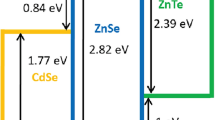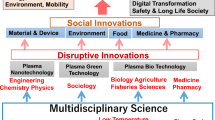Abstract
The research field of plasma–liquid interactions is quickly expanding due to its great potential in many applications, including nanomaterial synthesis. In this paper, we present a novel kind of in-liquid discharge that is generated at or near the interface of two immiscible liquids, water and liquid hydrocarbon. The optical emission characteristics of this discharge are studied using ICCD imaging, and their dependence on the position of the interface with respect to the electrode are analyzed. The results show that when the electrode is at the interface, discharge efficiency is optimal due to increased discharge probability and plasma volume. Moreover, when the electrical conductivity of the solution is increased beyond ~ 500 µS/cm, the discharge mode transits from streamer to spark. Analysis of the nanomaterial produced by interfacial discharges reveals that when the discharge is ignited at the interface of distilled water-heptane, amorphous carbonaceous sheet-like materials are formed; however, when Ni-nitrate is added to raise the electrical conductivity of water, Ni nanoparticles embedded in C-matrix are synthesized. Furthermore, the particle surface density in the C-sheet increases at higher electrical conductivity. As the discharge transits from streamer (low conductivity) to spark (high conductivity), the amorphous C-sheet becomes graphitized. When two or three salts (Ni-, and/or Co-, and/or Fe- nitrate) are added at the high conductivity condition (5000 µS/cm), nanoalloys (NiCo, NiFe, CoFe, and NiCoFe) embedded in C-matrix are formed. Overall, the data reported herein demonstrates interfacial discharges in liquid offer great opportunities for efficiently and ecologically synthesizing novel nanomaterials with unique properties.










Similar content being viewed by others
Data Availability
All data generated or analyzed in this study are included in the published article.
References
Rezaei F, Vanraes P, Nikiforov A, Morent R, De Geyter N (2019) Applications of plasma-liquid systems: a review. Materials 12(17):2751
Perinban S, Orsat V, Raghavan V (2019) Nonthermal plasma–liquid interactions in food processing: a review. Compr Rev Food Sci Food Saf 18(6):1985–2008
Morabit Y, Hasan MI, Whalley RD, Robert E, Modic M, Walsh JL (2021) A review of the gas and liquid phase interactions in low-temperature plasma jets used for biomedical applications. Eur Phys J D 75:1–26
Belmonte T, Hamdan A, Kosior F, Noël C, Henrion G (2014) Interaction of discharges with electrode surfaces in dielectric liquids: application to nanoparticle synthesis. J Phys D 47(22):224016
Chen Q, Li J, Li Y (2015) A review of plasma–liquid interactions for nanomaterial synthesis. J Phys D 48(42):424005
Mariotti D, Patel J, Švrček V, Maguire P (2012) Plasma–liquid interactions at atmospheric pressure for nanomaterials synthesis and surface engineering. Plasma Processes Polym 9(11–12):1074–1085
Richmonds C, Witzke M, Bartling B, Lee SW, Wainright J, Liu CC, Sankaran RM (2011) Electron-transfer reactions at the plasma–liquid interface. J Am Chem Soc 133(44):17582–17585
Elg DT, Delgado HE, Martin DC, Sankaran RM, Rumbach P, Bartels DM, Go DB (2021) Recent advances in understanding the role of solvated electrons at the plasma-liquid interface of solution-based gas discharges. Spectrochimica Acta Part B: Atomic Spectroscopy 186:106307
Oldham T, Thimsen E (2022) Electrochemical structure of the plasma–liquid interface. J Phys Chem C 126(2):1222–1229
Gorbanev Y, O’Connell D, Chechik V (2016) Non-thermal plasma in contact with water: the origin of species. Chemistry–A Eur J 22(10):3496–3505
Marinov I, Starikovskaia S, Rousseau A (2014) Dynamics of plasma evolution in a nanosecond underwater discharge. J Phys D 47(22):224017
Starikovskiy A, Yang Y, Cho YI, Fridman A (2011) Non-equilibrium plasma in liquid water: dynamics of generation and quenching. Plasma Sources Sci Technol 20(2):024003
Hamdan A, Cha MS (2015) Ignition modes of nanosecond discharge with bubbles in distilled water. J Phys D 48(40):405206
Hamdan A, Cha MS (2016) Nanosecond discharge in bubbled liquid n-heptane: effects of gas composition and water addition. IEEE Trans Plasma Sci 44(12):2988–2994
Deng H, He Z, Ma J, Xu Y, Liu J, Guo R (2010) Initiation and propagation of discharge in liquid droplets: effect of droplet sizes. IEEE Trans Plasma Sci 38(12):3282–3288
Dubinov AE, Kozhayeva JP, Lyubimtseva VA, Selemir VD (2019) Hydrodynamic and physicochemical phenomena in liquid droplets under the action of nanosecond spark discharges: a review. Adv Colloid Interface Sci 271:101986
Hamdan A, Cha MS (2022) Production of SiC nanoparticles in Carbon Network by Pulsed Electrical discharges in Liquid Hexamethyldisilazane with Gaseous bubbles. Plasma Chem Plasma Process 42(3):605–618
Hamdan A, Abiad DE, Cha MS (2021) Synthesis of silicon and silicon carbide nanoparticles by pulsed electrical discharges in dielectric liquids. Plasma Chem Plasma Process 41:1647–1660
Mohammadi K, Hamdan A (2021) Spark discharges in liquid heptane in contact with silver nitrate solution: investigation of the synthesized particles. Plasma Processes Polym 18(10):2100083
Glad X, Gorry J, Cha MS, Hamdan A (2021) Synthesis of core–shell copper–graphite submicronic particles and carbon nano-onions by spark discharges in liquid hydrocarbons. Sci Rep 11(1):1–12
Hamdan A, Agati M, Boninelli S (2021) Selective synthesis of 2D mesoporous CuO agglomerates by pulsed spark discharge in water. Plasma Chem Plasma Process 41:433–445
Agati M, Boninelli S, Hamdan A (2021) Atomic scale microscopy unveils the growth mechanism of 2D-like CuO nanoparticle agglomerates produced via electrical discharges in water. Mater Chem Phys 261:124244
Glad X, Profili J, Cha MS, Hamdan A (2020) Synthesis of copper and copper oxide nanomaterials by electrical discharges in water with various electrical conductivities. J Appl Phys 127(2):023302
Merciris T, Valensi F, Hamdan A (2021) Synthesis of nickel and cobalt oxide nanoparticles by pulsed underwater spark discharges. J Appl Phys 129(6):063303
Hamdan A, Noël C, Ghanbaja J, Belmonte T (2014) Comparison of aluminium nanostructures created by discharges in various dielectric liquids. Plasma Chem Plasma Process 34:1101–1114
Hamdan A, Noel C, Ghanbaja J, Migot-Choux S, Belmonte T (2013) Synthesis of platinum embedded in amorphous carbon by micro-gap discharge in heptane. Mater Chem Phys 142(1):199–206
Richmonds C, Sankaran RM (2008) Plasma-liquid electrochemistry: Rapid synthesis of colloidal metal nanoparticles by microplasma reduction of aqueous cations. Appl Phys Lett 93(13):131501
Velusamy T, Liguori A, Macias-Montero M, Padmanaban DB, Carolan D, Gherardi M, …, Mariotti D (2017) Ultra‐small CuO nanoparticles with tailored energy‐band diagram synthesized by a hybrid plasma‐liquid process. Plasma Processes Polym 14(7):1600224
Kondeti VSK, Phan CQ, Wende K, Jablonowski H, Gangal U, Granick JL, …, Bruggeman PJ (2018) Long-lived and short-lived reactive species produced by a cold atmospheric pressure plasma jet for the inactivation of Pseudomonas aeruginosa and Staphylococcus aureus. Free Radic Biol Med 124:275–287
Gorbanev Y, Privat-Maldonado A, Bogaerts A (2018) Analysis of short-lived reactive species in plasma–air–water systems. the dos and the do nots
Patel J, Němcová L, Maguire P, Graham WG, Mariotti D (2013) Synthesis of surfactant-free electrostatically stabilized gold nanoparticles by plasma-induced liquid chemistry. Nanotechnology 24(24):245604
Hamdan A, Cha MS (2016) Low-dielectric layer increases nanosecond electric discharges in distilled water. AIP Adv 6(10):105112
Hamdan A, Diamond J (2021) Electrical and optical characterization of a pulsed discharge in immiscible layered liquids: n-heptane and water with various electrical conductivities. Plasma Sources Sci Technol 30(5):055021
Hamdan A, Cha MS (2018) Carbon-based nanomaterial synthesis using nanosecond electrical discharges in immiscible layered liquids: N-heptane and water. J Phys D 51(24):244003
Hamdan A, Abdul Halim R, Anjum D, Cha MS (2017) Synthesis of SiOC: H nanoparticles by electrical discharge in hexamethyldisilazane and water. Plasma Processes Polym 14(12):1700089
Kondeti VSK, Gangal U, Yatom S, Bruggeman PJ (2017) Ag + reduction and silver nanoparticle synthesis at the plasma–liquid interface by an RF driven atmospheric pressure plasma jet: mechanisms and the effect of surfactant. J Vacuum Sci Technol A: Vacuum Surf Films 35(6):061302
De Vos C, Baneton J, Witzke M, Dille J, Godet S, Gordon MJ, …, Reniers F (2017) A comparative study of the reduction of silver and gold salts in water by a cathodic microplasma electrode. J Phys D 50(10):105206
Dorval A, Stafford L, Hamdan A (2023) J Phys D: Appl Phys. https://doi.org/10.1088/1361-6463/acfd39
Kamaraj SK, Thirumurugan A, de la Torre SD, Balasingam SK, Dhanabalan SS Functionalized magnetic nanomaterials and their applications. In Nanostructured magnetic materials (pp. 1–13). CRC Press
Zhen L, Gong YX, Jiang JT, Shao WZ (2008) Electromagnetic properties of FeNi alloy nanoparticles prepared by hydrogen-thermal reduction method. J Appl Phys, 104(3)
Lu W, Sun D, Yu H (2013) Synthesis and magnetic properties of size-controlled CoNi alloy nanoparticles. J Alloys Compd 546:229–233
Funding
This work was financially supported by the National Science and Engineering Research Council (NSERC) RGPIN-2023-03951.
Author information
Authors and Affiliations
Contributions
A Hamdan wrote the main manuscript text and prepared the Figures.
Corresponding author
Ethics declarations
Competing Interests
The authors declare no competing interests.
Ethics Approval and Consent to Participate
Not applicable.
Consent for Publication
Not applicable.
Additional information
Publisher’s Note
Springer Nature remains neutral with regard to jurisdictional claims in published maps and institutional affiliations.
Rights and permissions
Springer Nature or its licensor (e.g. a society or other partner) holds exclusive rights to this article under a publishing agreement with the author(s) or other rightsholder(s); author self-archiving of the accepted manuscript version of this article is solely governed by the terms of such publishing agreement and applicable law.
About this article
Cite this article
Hamdan, A. Exploring the Discharge Phenomenon at the Interface of Immiscible Liquids: Current Understanding and Potential Applications in Nanomaterial Synthesis. Plasma Chem Plasma Process (2023). https://doi.org/10.1007/s11090-023-10413-z
Received:
Accepted:
Published:
DOI: https://doi.org/10.1007/s11090-023-10413-z




